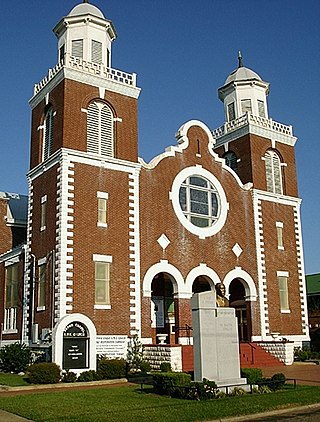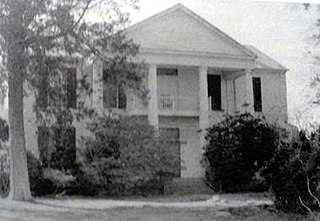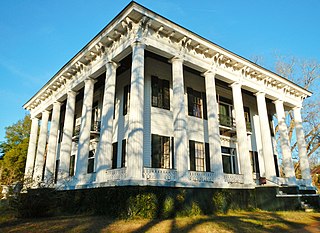
Dallas County is a county located in the central part of the U.S. state of Alabama. As of the 2020 census, its population was 38,462. The county seat is Selma. Its name is in honor of United States Secretary of the Treasury Alexander J. Dallas, who served from 1814 to 1816.

Lowndes County is in the central part of the U.S. state of Alabama. As of the 2020 census, the county's population was 10,311. Its county seat is Hayneville. The county is named in honor of William Lowndes, a member of the United States Congress from South Carolina.

Lowndesboro is a town in Lowndes County, Alabama, United States. At the 2010 census the population was 115, down from 140 in 2000. It is part of the Montgomery Metropolitan Statistical Area. Although initially incorporated in 1856 by an act of the state legislature, it lapsed and was not reincorporated until 1962.

The Jarrell Plantation State Historic Site is a former cotton plantation and state historic site in Juliette, Georgia, United States. Founded as a forced-labor farm worked by John Jarrell and the African American people he enslaved, the site stands today as one of the best-preserved examples of a "middle class" Southern plantation. The Jarrell Plantation's buildings and artifacts all came from the Jarrell family, who farmed the land for over 140 years. Located in the red clay hills of the Georgia piedmont, It was added to the National Register of Historic Places in 1973. It is a Georgia state park in Jones County.

Gaineswood is a plantation house in Demopolis, Alabama, United States. It is the grandest plantation house ever built in Marengo County and is one of the most significant remaining examples of Greek Revival architecture in Alabama.

Brown Chapel A.M.E. Church is a church at 410 Martin Luther King Jr. Boulevard in Selma, Alabama, United States. This church was a starting point for the Selma to Montgomery marches in 1965 and, as the meeting place and offices of the Southern Christian Leadership Conference (SCLC) during the Selma Movement, played a major role in the events that led to the adoption of the Voting Rights Act of 1965. The nation's reaction to Selma's "Bloody Sunday" march is widely credited with making the passage of the Voting Rights Act politically viable in the United States Congress.

Faunsdale Plantation is a historic slave plantation near the town of Faunsdale, Alabama, United States. This plantation is in the Black Belt, a section of the state developed for cotton plantations. Until the U.S. Civil War, planters held as many as 186 enslaved African Americans as laborers to raise cotton as a commodity crop.

Cedar Haven was a historic Greek Revival plantation house located near Faunsdale, Alabama. It was built in 1850 by Phillip J. Weaver. Weaver was a prominent merchant and planter. He was born in Mifflintown, Pennsylvania in 1797 and relocated to Selma from Uniontown, Maryland in 1818. He ran a very successful store in Selma and also maintained a home there. Weaver was the paternal grandfather of the artist Clara Weaver Parrish.

Roseland Plantation is a historic plantation complex site in Faunsdale, Alabama. The site is situated on a low hill at the end of a long driveway on the overgrown estate. It was added to the National Register of Historic Places on January 20, 1994, as a part of the Plantation Houses of the Alabama Canebrake and Their Associated Outbuildings Multiple Property Submission.

Hawthorne, also known as the Browder Place, is a historic Italianate plantation house and historic district in Prairieville, Alabama, USA. This area of Hale County was included in Marengo County before the creation of Hale in 1867. Hawthorne is included in the Plantation Houses of the Alabama Canebrake and Their Associated Outbuildings Multiple Property Submission. It was added to the National Register of Historic Places on July 7, 1994, due to its architectural significance.

The following outline is provided as an overview of and topical guide to the U.S. state of Alabama:
The Brame House, also known as the Brame-Cody-Neal House, was a historic Classical Revival-style house in Montgomery, Alabama. The two-story frame house was built in 1897 by W.W. Brame. It was added to the Alabama Register of Landmarks and Heritage on January 29, 1980, and to the National Register of Historic Places on September 17, 1980. The house was demolished in 1990, after some attempts were made to save it.

"Meadowlawn", also known as the '"Hagood House", is an antebellum plantation house, built in the Greek revival style, in Lowndsboro, Alabama, United States. It is a contributing property to the Lowndesboro Historic District, which was added to the National Register of Historic Places on December 12, 1973.

The 'Wesley Plattenburg House is a historic house in Selma, Alabama. Featuring a unique combination of the Greek Revival and Italianate styles, it was completed in 1842 for Wesley Plattenburg. Plattenburg was born on April 13, 1803, in Anne Arundel County, Maryland. He had relocated to Selma and had assumed the occupation of tailor by 1829. He became a successful merchant and served on the city council of Selma for many years.

The James Spullock Williamson House, also known as Merry Oaks, is a historic plantation house in the rural community of Sandy Ridge in Lowndes County, Alabama. The one-story Greek Revival-style house was completed circa 1860.
Pintlala, also known as Pint Lala or Colquitt, is an unincorporated community in Montgomery County, Alabama, United States, located on U.S. Route 31, 15.6 miles (25.1 km) south of Montgomery.

Preuit Oaks is a historic plantation house near Leighton in Colbert County, Alabama. The house was built in 1847 by Dr. John S. Napier, on land originally owned by his father-in-law. The house and land were sold in 1851 to W. Richard Preuit, who developed the property into a large cotton plantation using the forced labour of enslaved people. At its peak in 1860, the plantation covered 1,500 acres ; following the Civil War, its productivity declined, and Preuit's holdings had depleted to only 400 acres upon his death in 1882. The house has remained in the family since.
Robert "Bob" Mants, Jr. was an American civil rights activist, serving as a field secretary for the Student Nonviolent Coordinating Committee (SNCC). Mants moved to Lowndes County, working for civil rights for the remainder of his life. Lowndes County contained the majority of the distance covered by the 1965 Selma to Montgomery march, and was then notorious for its racist violence.

The Alabama Black Belt National Heritage Area is a National Heritage Area encompassing Bibb, Bullock, Butler, Choctaw, Clarke, Conecuh, Dallas, Greene, Hale, Lowndes, Macon, Marengo, Monroe, Montgomery, Perry, Pickens, Sumter, Washington, and Wilcox counties in the Black Belt region of Alabama. The Center for the Study of the Black Belt at the University of West Alabama serves as the local coordinating authority.




















